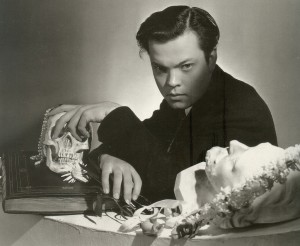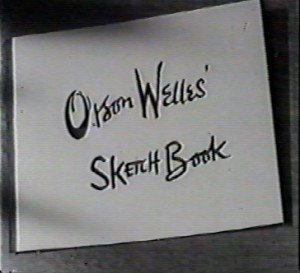From Film Quarterly, Winter 1990–91.-– J.R.

Orson Welles: A Bio-Bibliography, by Bret Wood (Westport, CT: Greene Press, 1990).
Issued without dust wrappers and priced beyond the range of most individuals, this 364-page book is clearly intended for libraries, and not likely to get much attention outside of specialized publications. But as a multifaceted research tool for anyone investigating the career of Orson Welles it is a veritable godsend — more valuable in some ways than any of the Welles biographies published so far.
Not counting introduction, endnotes, index, a skeletal Welles chronology, an invaluable section devoted to special sources, and ten well-chosen illustrations, the book is divided into eight sections: Biographical Sketch, Theatre Credits, Radio Credits, Film Credits, Welles as Author, Discography (a brief section that regrettably excludes commercial releases of radio broadcasts), Books and Monographs on Welles, and Articles on Welles. Probably the most valuable of these sections in terms of fresh material are the two longest, Radio Credits (74 pages) and Film Credits (120 pages), containing not only listings but, in many cases, descriptive and critical annotations. (The length of the film section can largely be accounted for by the fact that Wood is as attentive to unrealized projects as he is to finished works.)
I don’t mean to suggest that Wood’s research skills are infallible or that his book doesn’t contain its share of typos, syntactical ambiguities, factual errors, and glaring omissions. But given the difficulty and intricacy of Welles’s career as an object of study, he has generally acquitted himself admirably. Welles scholars have neglected particularly the bulk of the radio work and such lesser known film projects as Don’t Touch Me, Carmen, and Salome.
Regarding Welles’s radio work, he offers the first thing that even remotely approaches a comprehensive account, with a keen sensitivity to how that work relates to Welles’s work in both film and theater. Apart from a few patches in John Houseman’s Run-Through and Frank Brady’s fascinating but unreliable Citizen Welles, virtually all of Welles’s chroniclers and critics have paid only glancing lip-service to this vast, undiscovered continent in Welles’s oeuvre. Although many people still believe that Welles’s film career essentially began and ended with Citizen Kane, there are surely even more who assume that his radio career began and ended with The War of the Worlds. Considering the fact that Welles did hundreds of radio broadcasts, educated and detailed commentary on this work has been by far the most gaping lacuna in Welles studies.
Wood has listened to all of Welles’s groundbreaking, seven-part adaptation of Les Miserables in 1937, can pinpoint many of the individual highlights of First Person Singular and Mercury Theatre on the Air (1938), The Campbell Playhouse (1938–1940), and subsequent shows through the later forties, and is able to trace (for instance) the style and format of The Orson Welles Almanac in 1944 back to Welles’s several appearances on Jack Benny’s show in 1943. He clearly qualifies as the first serious scholar to write at any length about these matters. While one can differ with some of his individual judgments — I happen to rank Welles’s controversial and political 1941 radio play His Honor, the Mayor much higher than he does, largely because of Welles’s remarkable neo-Brechtian narration — there’s no question that Wood dwarfs all his predecessors in his detailed assessments of Welles’s radio work.
The bibliographical sections, on the other hand, while they contain many entries that were unfamiliar to me, are as notable in some ways for what they leave out as for what they include. Although Wood neglects to mention this, his list of books and monographs completely excludes non-English works, and most other items are also in English. The principles for inclusion often seem curious and haphazard: two pieces in Confidential about Welles’s love life are cited, but neither of the two prominent manifestos by Welles and Houseman about the Mercury Theater that appeared in the New York Times; and even Peter Bogdanovich’s celebrated “The Kane Mutiny” — published in Esquire and reprinted in a volume Wood cites elsewhere — goes unmentioned.
Wood fails to note that Fletcher Markle was the credited author of the Salome treatment he discusses and incorrectly states that Welles’s TV documentary about Gina Lollobrigida was “never completed” (when it was both discovered and shown in its entirety at the Venice film festival a few years ago). Many of these and other errors or omissions can be traced back to printed sources elsewhere — a recurring problem that is especially acute when it comes to Wellesian matters — although it also suggests that some matters received much more of Wood’s attention than others. (Curiously, he seems completely unaware of the bulk of Welles’s work for European TV — including such series as Orson Welles Sketchbook, Around the World with Orson Welles, and In the Land of Don Quixote.) But these are only niggling reservations about an indispensable resource for all Welles scholars.



